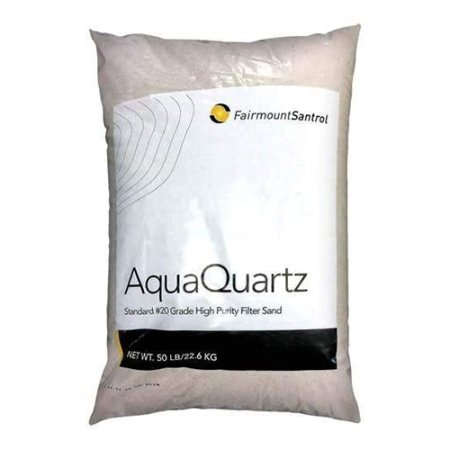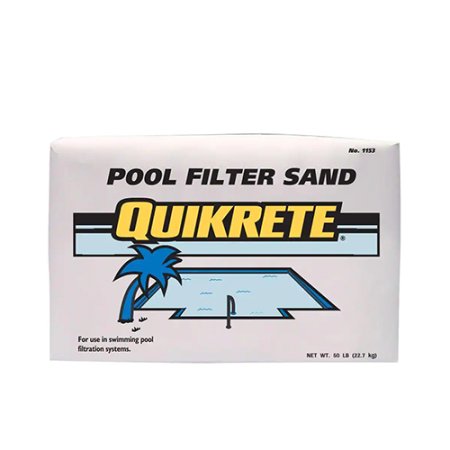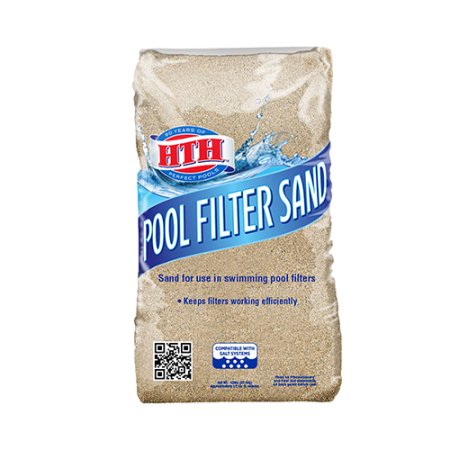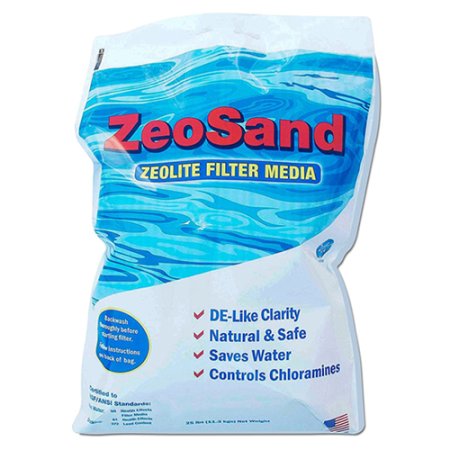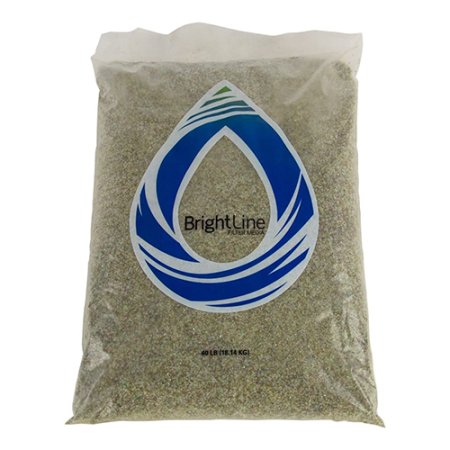We may earn revenue from the products available on this page and participate in affiliate programs.
Reading up on Domino’s shopping guides is like having your own personal product concierge. We do the tedious part—deep-dive research, hands-on testing, and tapping experts for advice—so all you have to do is hit “add to cart.” That’s why we call them Simply the Best.
Here’s the biggest piece of advice we can give you when it comes to the best pool filter sand: Find a product that lets you delay changing it for as long as humanly possible. Seriously, it’s a dirty job—filter sand gathers everything, from hair and oil to algae spores and all other manner of impurities from your pool season after season. While the bulk of the sand out there is silica based, there are filter media that use lava rock minerals, recycled glass, and even polyester balls to keep your pool clear. Though silica alternatives may cost more, they often last much longer, so you don’t have to change the sand as often. If your filter is churning out cloudy water and it’s time for a change, read on to find out what the best options are.
Our Favorites
- Best overall: AquaQuartz
- Best value: Quikrete Pool Filter Sand
- Best above-ground: HTH Pool Care Filter Sand
- Best zeolite: ZeoSand
- Best glass: Harsco Metal & Minerals Filter Glass
- Best sand alternative: Vazillo Pool Filter Balls
Best Overall: AquaQuartz
Best Overall
Shop NowType: Silica | Weight: 50 pounds | Filtration: Down to 20 microns
What we like:
- Mined, so there are no chemical additives
- Won’t stain your pool walls or liner
- Resists clogging and channeling
Worth noting:
- Comes in heavy 50-pound bags
Why we chose it: It’s affordable, removes contaminants better than most silica filter sand, and won’t add any chemicals to your pool water.
The nice thing about AquaQuartz is that it’s mined instead of manufactured, so you’ll know you won’t be adding any chemicals to your water when you use it. And while some silica filter sands will only remove particles as small as 30 microns, AquaQuartz can remove them as small as 20 microns, meaning it will snag most dirt, hair, algae, and other icky stuff that finds its way into your pool water.
AquaQuartz also resists clumping, so you’re less likely to end up with channeling, an annoying problem in which water creates a tunnel through the sand, rendering the filter useless until the clump is manually broken up.
Best Value: Quikrete Pool Filter Sand
Best Value
Shop NowType: Silica | Weight: 50 pounds | Filtration: Down to 40 to 20 microns
What we like:
- Half the cost of other silica sands
- Graded for use in swimming pools
- Will last up to 5 years
Worth noting:
- Doesn’t filter as well as other filter sand
Why we chose it: If you’re looking for the affordable option, you won’t find a better one than Quikrete.
Despite its name, this sand won’t solidify into concrete if you put it in your pool filter. Quikrete pool filter sand costs about half the price of other silica filter sand products, but before you opt for this budget pick, be aware that it may not get your pool as clean as other options. Quickrete’s pool sand is coarser than others, meaning it can only remove particles somewhere in the neighborhood of 40 to 20 microns in size. If you’re already having a hard time keeping things clear and algae-free, you’ll probably want to fork over the additional cash for a filter sand capable of giving your pool water a more thorough cleaning.
Best Above Ground: HTH Pool Care Filter Sand
Best Above Ground
Shop NowType: Silica | Weight: 50 pounds | Filtration: Down to 20 microns
What we like:
- Smaller grains trap more debris
- Works with most pool types
- Undergoes a washing process that removes impurities
Worth noting:
- Might be too lightweight for some above-ground filters
Why we chose it: It’s usable in virtually any pool or spa, including above-ground pools.
The nice thing about this filter sand is its versatility. It doesn’t matter if you have an above-ground or in-ground pool or one that’s even saltwater—HTH is compatible with all of them. As with most other silica-based pool sands, it will remove contaminants as small as 20 microns. Its smaller 0.45-millimeter particles are capable of trapping even tinier debris, though this may make it unsuitable for some more powerful in-ground pump and filter systems.
HTH also puts its sand through a washing process after its mined to ensure no contaminants end up in the bag—that way you know it doesn’t contain harmful chemicals that might alter the chemistry in your pool or stain its sides.
Best Zeolite: ZeoSand
Best Zeolite
Shop NowType: Zeolite | Weight: 50 pounds | Filtration: Down to 10 microns
What we like:
- Removes smaller particles
- Rids your pool of chloramines
- Cleaning equivalent of 100 pounds of silica
Worth noting:
- More than twice the cost of silica sand
Why we chose it: The volcanic minerals in this filter sand remove smaller particles than silica.
Technically, ZeoSand isn’t really sand at all; it consists of minerals found in volcanic rock. It also does a better job of cleaning your pool water. That’s because it can remove particles as small as 10 microns, an upgrade over the max 20 microns that silica sand will snag. It also has the added benefit of latching onto chloramines, those nasty little by-products of chlorine that make your eyes red and itchy and make it harder for free chlorine to do its job.
While ZeoSand is more than twice the cost of standard silica sand, you can use 50 percent less of it in your filter. It also lasts longer, so you won’t have to go through the process of changing the sand in your pool filter as often.
Best Glass: Harsco Metal & Minerals Filter Glass
Best Glass
Shop NowType: Glass | Weight: 40 pounds | Filtration: Down to 5 microns
What we like:
- Removes tiny particles down to 5 microns
- Lasts 3 times longer than sand
- Made from recycled materials
Worth noting:
- More than twice the cost of silica filter sand
Why we chose it: This glass-based sand lasts longer than silica and it’s made from recycled materials.
Yes, a 40-pound bag of this glass filter media costs more than twice as much as a standard bag of silica sand. But if you’re willing to pay a higher cost up front, you may end up saving money in the long run and have clearer pool water, to boot. That’s because you can load 20 percent less of this glass into your filter than you would silica sand, and it lasts three times longer. What’s more, it does a better job of cleaning your pool’s water since it can filter out particles as small as 5 microns, much tinier than the 20 microns that standard silica sand can remove. You can also feel good about using it since it’s made from 100 percent recycled glass.
Best Sand Alternative: Vazillo Pool Filter Balls
Best Sand Alternative
Shop NowType: Filter balls | Weight: 3.1 pounds | Filtration: Down to 3 microns
What we like:
- Lightweight
- Eco-friendly fiber
- Can be refreshed in the washing machine
Worth noting:
- More expensive and doesn’t last as long as silica
Why we chose it: These unconventional cleaners scrub the water better than sand and are much easier to work with.
If lugging around what might feel like an entire beach’s worth of sand doesn’t appeal to you, consider this lightweight alternative. These filter balls fit inside your sand filter, weigh in at a little more than 3 pounds, and have the cleaning equivalent of more than 100 pounds of sand (!). As water flows through the filter, it passes through these balls, which removes particles as small as 3 microns. Unlike sand, the balls won’t clog your filter and require backwashing less often. They even come with a mesh bag that allows you to simply throw them in the washing machine for reuse. If you’re looking for a budget buy, you might want to try anther option on this list. These come in at about twice as much as silica sand and will only last for a couple of seasons before you need to replace them.
How We Chose These Products
Filter sand varies in type, price, and ability to remove the stuff you don’t want in your pool water. Our list gives you a variety of options to suit different budgets and water-quality needs. With that in mind, we’ve included silica pool sand as well as higher-priced glass and zeolite products. While the former may be all many pools need, owners who struggle with cloudy water and algae growth may want to opt for higher-priced products. In addition to more traditional filter sands, we also included an alternative for those who are willing to pay more for a filter media that provides exceptional results without requiring you to toil over very heavy bags.
Our Shopping Checklist
Types of Filter Sand
Not all filter sand is the same, so it’s important to understand what types are on the market before committing to a style.
Silica: This is the type that’s most commonly found on the shelves of pool supply stores. It’s affordable and capable of filtering particles as small as 20 microns, which includes most of what you’ll want to get rid of in favorite clear water.
Zeolite: It’s more expensive, but these tiny minerals come from volcanic rock and will trap particles as small as 10 microns, which will take care of smaller particles. It also has an extra hidden benefit, as mentioned above—zeolite can latch onto and remove chloramines, which can irritate the eyes and nose.
Glass: If you have a recurring algae problem in your pool, it might make sense to spring for glass pool filter sand. Why? Algae spores are often too small for silica or even zeolite to trap. Since glass filter sand is capable of trapping particles as small as 3 microns, it will remove those spores, nipping your algae problem in the bud.
Grain Size
While grains of sand may seem very tiny, they can actually range significantly in size. Why should you care? If the sand in your filter is too fine, the water that flows through it will carry it into the pool. Too large and the sand will fail to trap smaller particles, allowing them to flow back into the water. What’s that just-right grain size? Look for filter sand with grains that fall in the range of 0.45 to 0.55 millimeters.
Above-Ground vs. In-Ground Pools
Sand is sand, so it makes no difference whether you put it in an above-ground or in-ground filter, right? Wrong. The difference between an above-ground and in-ground pool filter is the power of the pump and filter system. Above-ground pool filters sit below water level in close proximity to the pool, and thus need a less powerful pump to draw the water from the pool and move it through the filter. This lower-power pump means you can use finer sand as small as 0.45 millimeters without worrying that the pump will carry the sand into the pool.
Such is not the case with in-ground pools, which have more powerful pumps that would produce enough force to carry that sand out of the filter and into the pool. Go with heavier sand above 0.5 millimeters to ensure a beach doesn’t start forming on your pool’s bottom.
Ask Domino
Q: Is pool filter sand different from regular sand?
The difference between pool filter sand and regular sand is the size of the granules. The sand in a child’s sandbox, for example, is much coarser, measuring up to 2 millimeters across. Pool filter sand, in comparison, is much finer, at just 0.4 to 0.55 millimeters in diameter. These smaller sand particles are better able to snag impurities as they pass through the filter.
Q: How much sand do I need for a pool filter?
This depends on how large the filter is. You’ll need 100 pounds of sand to fill a 16-inch sand filter. If your filter is larger than 16 inches, add an additional 25 pounds of sand for each additional inch. Thus an 18-inch sand filter would need 150 pounds of sand.
Q: How often should I change pool filter sand? What are the telltale signs it needs to be replaced?
Eventually the edges on grains of sand wear down and become smooth, which means they lose the ability to trap contaminants. Signs that your sand is no longer working include cloudy water, the appearance of tiny debris that isn’t normally in the pool, and difficulty maintaining the proper chemistry. You should replace the sand in your filter an average of every three to five years. The sand can last a shorter or longer period of time depending on how long the filter runs.
Q: Should sand come out when I backwash?
The process of backwashing your filter is necessary to rinse out contaminants that the sand has trapped in it. By backwashing, you can extend the life of the sand, extending the time between when you’ll need to replace it. Sand should not come out when you backwash the filter. If it is, that likely means there is internal damage to your filter that needs to be addressed by a professional.
The Last Word
While prices vary considerably, it’s important to balance the cost with effectiveness of pool filter sand. Glass or zeolite filter sand may be more expensive up front, but it will do a better job of cleaning your pool water and extend the time between when you need to change the filter sand (our favorite attribute). That said, if your pool chemistry is fairly stable and you don’t have problems with algae growth, it probably makes sense to stick with a more affordable filter sand.

